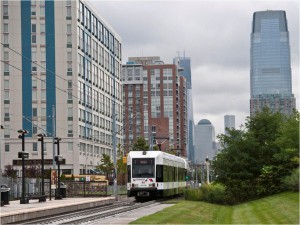New Jersey Future Blog
Research Reveals Recession’s Leveling Effect on Residential Development
October 6th, 2015 by New Jersey Future staff
This article was written by New Jersey Future intern Harrison Blackman, who did the underlying data analysis.
Much has been made of the slowdown in residential development in the wake of the 2008 financial meltdown and the ensuing Great Recession. At the same time, many commentators have noted the growing popularity of mixed-use, walkable urban areas among members of the rising Millennial generation.
Results from recent research appear to reaffirm both these narratives. The research suggests that while less built-out places grew more rapidly than highly built-out places before the recession (as measured by issuance of certificates of occupancy), the two types of places are now growing at similar rates. That is, redevelopment is now keeping pace with “greenfield” development.
Methods
Municipal built-out percentages for the year 2002, which was used as the baseline, were calculated using data developed by researchers at Rutgers and Rowan universities. The total amount of land developed was divided by the total amount of “developable” land, which includes already-developed land and land that may still be developed in the future, while excluding lands that are undevelopable, either because they are environmentally constrained or because they have been permanently preserved.
In this study, the 204 municipalities that were at least 90 percent built out in 2002 were defined as “redevelopment municipalities,” under the assumption that, given the shortage of developable land, any new population or employment growth in such places is likely to be accommodated through redevelopment or infill.
Redevelopment municipalities were considered against the rest of the state — that is, all municipalities that were less than 90 percent built out in 2002.
Residential certificates of occupancy (COs) from the New Jersey Department of Community Affairs for the years 2000 through 2013 were used to measure additions to the housing stock. We considered the number of COs issued as a percentage of the total number of housing units in 2000 as a reasonable estimate of the trend in housing growth pre- and post-recession.
Findings
Before the recession – that is, for the years 2000 through 2007 – redevelopment municipalities had a significantly lower growth in COs issued than did less built-out municipalities, with more than 75 percent of the redevelopment municipalities having CO growth rates falling below the median growth rate of 6.25 percent among the non-redevelopment municipalities. Redevelopment municipalities issued COs at a median rate of 2.14 percent of baseline housing stock – 65.8 percent lower than the median for non-redevelopment areas. Thus, pre-recession, suburban and rural places added new housing units at much faster rates than did older, built-out urban areas.
Between 2008 and 2013, however, while growth rates in COs for both subsets declined significantly, they declined to about the same rate. The growth rate in COs issued for redevelopment municipalities was 1.08 percent, and 1.46 percent for the other group of municipalities. This suggests that the economic crisis exerted a leveling effect on development throughout New Jersey, stalling excess demand for COs in less urbanized areas and bringing the growth rates of the two categories of municipalities closer together. Looked at another way, older, more built-out urban places tended to weather the recession better than still-developing suburban and rural places.
Now that the playing field appears to be level, it will be interesting to see what patterns emerge in the next decade.

















